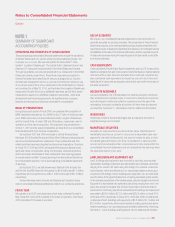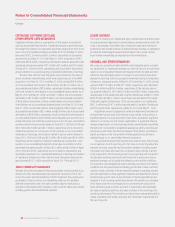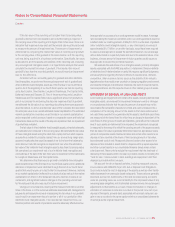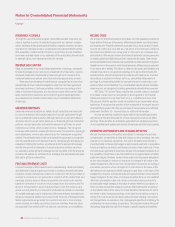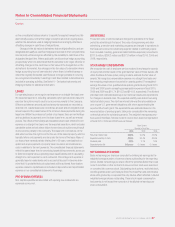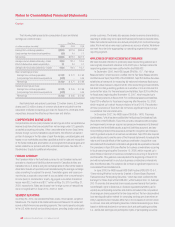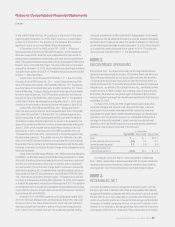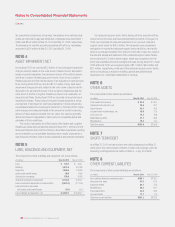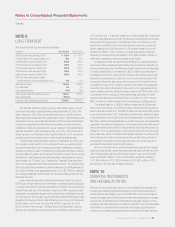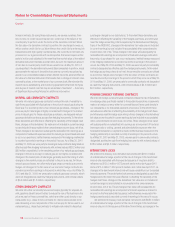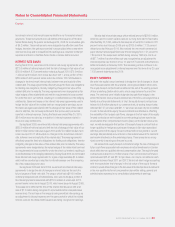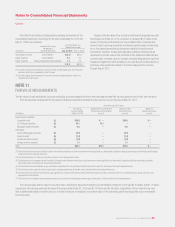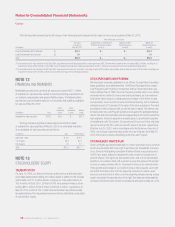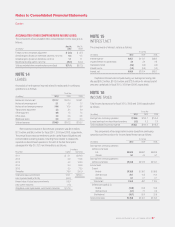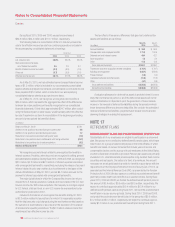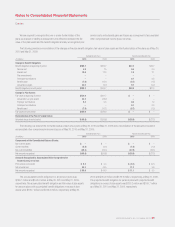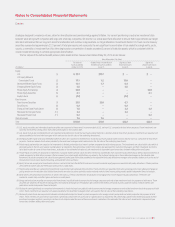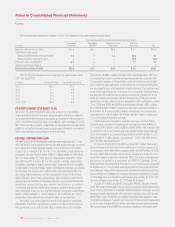Red Lobster 2010 Annual Report Download - page 54
Download and view the complete annual report
Please find page 54 of the 2010 Red Lobster annual report below. You can navigate through the pages in the report by either clicking on the pages listed below, or by using the keyword search tool below to find specific information within the annual report.
forward contracts. By using these instruments, we expose ourselves, from
time to time, to credit risk and market risk. Credit risk is the failure of the
counterparty to perform under the terms of the derivative contract. When
the fair value of a derivative contract is positive, the counterparty owes us,
which creates credit risk for us. We minimize this credit risk by entering into
transactions with high quality counterparties. We currently do not have any
provisions in our agreements with counterparties that would require either
party to hold or post collateral in the event that the market value of the related
derivative instrument exceeds a certain limit. As such, the maximum amount
of loss due to counterparty credit risk we would incur at May 30, 2010, if
counterparties to the derivative instruments failed completely to perform, would
approximate the values of derivative instruments currently recognized as
assets in our consolidated balance sheet. Market risk is the adverse effect on
the value of a financial instrument that results from a change in interest rates,
commodity prices, or the market price of our common stock. We minimize this
market risk by establishing and monitoring parameters that limit the types
anddegreeofmarketriskthatmaybeundertaken.SeeNote1–Summary
of Significant Accounting Policies for additional information.
NATURAL GAS COMMODITY CONTRACTS
We enter into natural gas swap contracts to reduce the risk of variability in
cash flows associated with fluctuations in the price of natural gas during the
fiscal year. For a certain portion of our natural gas purchases, changes in the
price we pay for natural gas is highly correlated with changes in the market
price of natural gas. For these natural gas purchases, we designate natural
gas swap derivative contracts as cash flow hedging instruments. To the extent
these derivatives are effective in offsetting the variability of the hedged cash
flows, changes in the derivatives’ fair value are not included in current earnings
but are included in accumulated other comprehensive income (loss), net of tax.
These changes in fair value are subsequently reclassified into earnings as a
component of restaurant expenses when the natural gas is purchased and used
by us in our operations. Ineffectiveness measured in the hedging relationship
is recorded currently in earnings in the period it occurs. As of May 30, 2010
and May 31, 2009, we were party to natural gas swap contracts designated as
effective cash flow hedging instruments with notional values of $3.2 million and
$9.9 million, respectively. For the remaining portion of our natural gas purchases,
changes in the price we pay for natural gas are not highly correlated with
changes in the market price of natural gas, generally due to the timing of when
changes in the market prices are reflected in the price we pay. For these
natural gas purchases, we utilize natural gas swap contracts as economic
hedges. All changes in the fair value of our economic hedge contracts are
recorded currently in earnings in the period in which they occur. As of May 30,
2010 and May 31, 2009, we were party to natural gas swap contracts, which
were not designated as cash flow hedging instruments, with notional values
of $0.6 million and $1.3 million, respectively.
OTHER COMMODITY CONTRACTS
We enter into other commodity futures and swaps (typically for soybean oil,
milk, gasoline, diesel fuel and butter) to reduce the risk of fluctuations in the
price we pay for these commodities, which are either used directly in our
restaurants (e.g., class III milk contracts for cheese and soybean oil for
salad dressing) or are components of the cost we pay for items used in our
restaurants (e.g., diesel fuel contracts to mitigate risk related to diesel fuel
surcharges charged by our distributors). To the extent these derivatives are
effective in offsetting the variability of the hedged cash flows, and otherwise
meet the hedge accounting criteria required by the Derivatives and Hedging
Topic of the FASB ASC, changes in the derivatives’ fair value are not included
in current earnings but are included in accumulated other comprehensive
income (loss), net of tax. These changes in fair value will subsequently be
reclassified into earnings as a component of food and beverage costs when
the product is purchased for use in our restaurants. Ineffectiveness measured
in the hedging relationship is recorded currently in earnings in the period it
occurs. As of May 30, 2010 and May 31, 2009, we were not party to commodity
contracts designated as effective cash flow hedging instruments. To the extent
the hedge accounting criteria is not met, the commodity contracts are utilized
as economic hedges and changes in the fair value of these contracts are
recorded currently in earnings in the period in which they occur. As of May 30,
2010 and May 31, 2009, we were party to commodity contracts not designated
as cash flow hedging instruments, with notional values of $4.2 million and
$0.3 million, respectively.
FOREIGN CURRENCY FORWARD CONTRACTS
We enter into foreign currency forward contracts to reduce the risk of fluc tuations
in exchange rates specifically related to forecasted transactions or payments
made in a foreign currency either for commodities and items used directly in
our restaurants or for forecasted payments of services. To the extent these
derivatives are effective in offsetting the variability of the hedged cash flows,
and otherwise meet the hedge accounting criteria, changes in the derivatives’
fair value are not included in current earnings but are included in accumulated
other comprehensive income (loss), net of tax. These changes in fair value
will subsequently be reclassified into earnings as a component of food and
beverage costs or selling, general and administrative expense when the
forecasted transaction or payment is made. Ineffectiveness measured in the
hedging relationship is recorded currently in earnings in the period it occurs.
As of May 30, 2010 and May 31, 2009, we were party to commodity contracts
designated as effective cash flow hedging instruments with notional values of
$18.9 million and $4.3 million, respectively.
INTEREST RATE LOCKS
We entered into treasury-lock derivative instruments with $150.0 million
of notional value to hedge a portion of the risk of changes in the benchmark
interest rate associated with the expected issuance of long-term debt to
refinance our $150.0 million 4.875 percent senior notes due August 2010
and our $75.0 million 7.450 percent medium-term notes due April 2011, as
changes in the benchmark interest rate will cause variability in our forecasted
interest payments. These derivative instruments are designated as cash flow
hedges and to the extent they are effective in offsetting the variability of the
hedged cash flows, changes in the derivatives’ fair value are not included in
current earnings but are included in accumulated other comprehensive
income (loss), net of tax. These changes in fair value will subsequently be
reclassified into earnings as a component of interest expense as interest is
incurred on the forecasted debt issuance. Ineffectiveness measured in the
hedging relationship is recorded currently in earnings in the period it occurs.
We entered into treasury-lock derivative instruments with $550.0 million
of notional value to hedge a portion of the risk of changes in the benchmark
interest rate prior to the issuance of the New Senior Notes, as changes in the
52 DARDEN RESTAURANTS, INC. | 2010 ANNUAL REPORT
Notes to Consolidated Financial Statements
Darden



